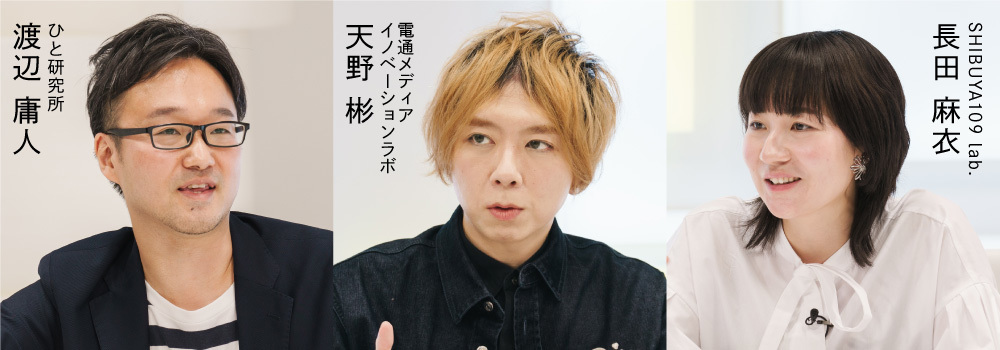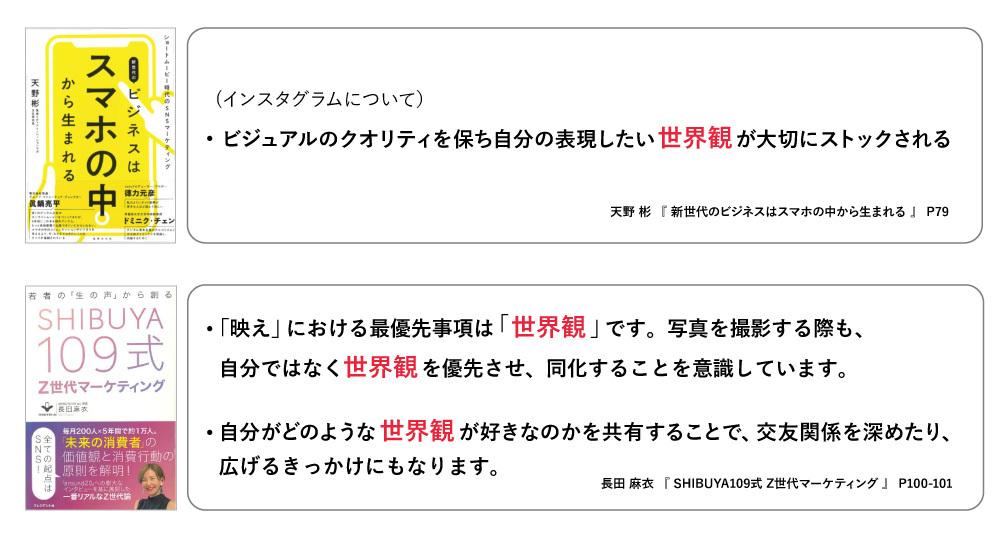How do Generation Z trends emerge?
How has the proliferation of AI changed information exposure?
How have consumers' spending habits, values, and media behaviors evolved through the pandemic and SNS advancements? Focusing on Generation Z, we decipher the "present" state of the relationship between consumers and media. Moderated by Mr. Masato Watanabe of Video Research Ltd.'s Human Research Institute, the discussion featured Ms. Mai Osada, Director of SHIBUYA109 lab., and Mr. Akira Amano, Senior Researcher at Dentsu Inc. Media Innovation Lab., both active at the forefront of consumer research.
※This article is edited from the session "How Will Media Behavior Change?" held at "VR FORUM 2023" on November 28, 2023.
Perspective for Understanding Today ① The Spread of Internet Video. Capturing the Viewing Journey.
Watanabe: First, I'd like to share the latest consumer insights from our ongoing consumer research. Starting with me from the Human Research Institute, I'll discuss consumer research centered on video viewing behavior.
Hito Research Institute studies video viewing, and we observed significant changes during the three years of the pandemic. The most substantial shift was the widespread adoption of internet video. YouTube's three-month usage rate reached 90%, while users of other internet video services surged 3 to 5 times over these three years. The pandemic created a "void in entertainment." With limited leisure options and restricted social interactions, people increasingly focused on how to access enjoyable content and spent more time doing so.
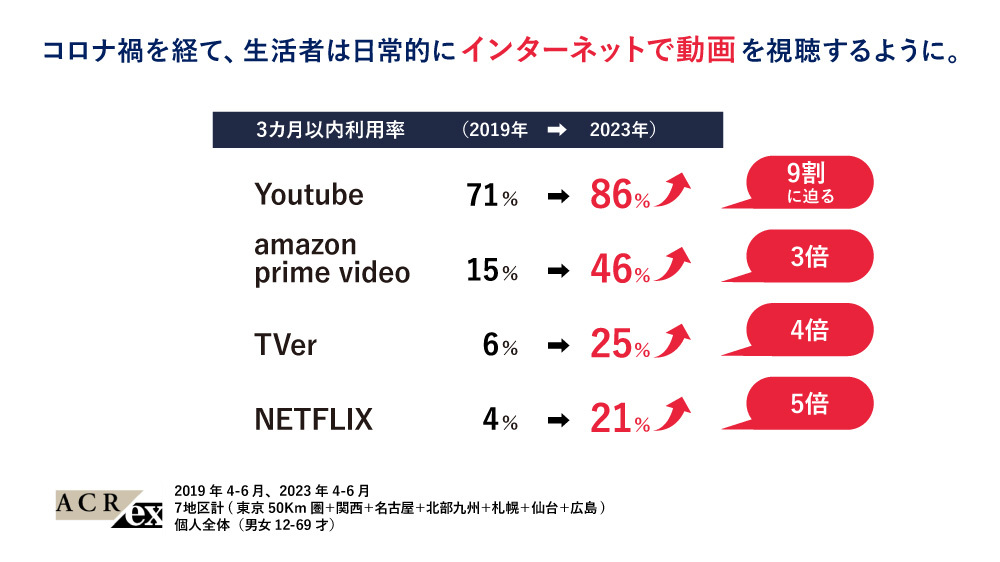

Watanabe: Simultaneously, how people spend time in the living room has changed. Beyond the expansion of connected TVs (TVs with internet connectivity), 13% of respondents said, "Even when my family is watching TV, I increasingly watch online videos on my smartphone or other devices without paying attention." I feel that the pandemic has brought about changes in lifestyle habits and attitudes.
Amidst these changes, content is no longer just something to watch; it has become a "viewing experience." This experience encompasses not only the content itself but also the surrounding consumer behaviors, such as gathering information before watching or sharing on social media afterward. We propose calling this entire sequence the "viewing journey." To enhance satisfaction with the viewing experience, we believe it is crucial to understand this "viewing journey."
In summary, the desire to fill the void of "entertainment" has led to changes in behavior and habits, increasing the importance of the "viewing experience." Companies (including broadcasters and advertisers) must grasp the "viewing journey," engage on the same level as consumers, and enhance the satisfaction of the viewing experience.
Perspective 2 for Understanding Today: Gen Z's "Community Consumption" and Affinity
Watanabe: We've discussed societal changes in media and consumers in general. Focusing specifically on Generation Z, what consumption behaviors and values do they exhibit today? Mr. Nagata, please share your insights.
Nagata: Yes. At SHIBUYA109 lab., a research lab studying youth, I speak with 200 young people aged 15-24 every month, conducting daily surveys on trends and consumption values. Based on these insights, I'll introduce Gen Z's consumption behaviors and values.
Four major keywords define Gen Z's consumption behavior:
- "Experience-based consumption": They value "experiences" that can be shared and empathized with over "things."
- "Fear of Failure Consumption": They avoid failure in shopping, content consumption, and career choices.
- "Selective Spending" – Carefully choosing where to invest money and time amidst overwhelming content.
- "Support-Driven Consumption": Spending money to support and contribute to people, such as through "favorite" activities.
And the latest major characteristic of Generation Z is "niche consumption." As values and preferences become more fragmented and diverse, mass appeal is fading, leading to an increase in this "niche consumption." It's a consumption behavior where small communities (niche groups) formed around loose axes like fashion preferences, shared favorite idols, or hobbies passionately enjoy a single trend.
This "niche consumption" is also changing how trends emerge. Trends now gradually spread from a single niche before becoming mainstream. To create trends, it's crucial to properly understand and engage with a specific niche.
From the perspective of media and content, which is today's main topic, people are exposed to an enormous amount of content, making them extremely critical about credibility. I believe a key factor in their credibility judgment is whether they can feel a sense of "familiarity."
For example, even high-quality videos on TikTok can be skipped if they feel unfamiliar. Conversely, videos with rougher production values, clearly made by someone of their own generation, tend to resonate more because they feel relatable. To reach them, I think it's crucial to have a range of approaches – not just high-quality creative, but also content that feels approachable and relatable.
Amano: That's definitely true. Beyond just the range of creative content, with the diversification of content and platforms, it's also important to tailor what you put out. I like K-POP, and there are official music videos, dance videos, and content focused on individual members. At live events, filming is allowed, and fans spread videos and images. They reach users from various angles and approaches, right?
Watanabe: By having diverse creative content and delivery methods, accumulating touchpoints from multiple directions seems likely to result in longer viewing times and greater overall exposure.
Perspective 3: AI and Algorithms Are Changing How We Encounter Information
Watanabe: Since TikTok came up, could you tell us about the impact of short videos, like those on TikTok, and how they're changing how we encounter information?
Amano: Summarizing the evolution of media and information changes broadly: previously, distribution was limited to "traditional media." Then "search engines" like Google and Yahoo! emerged, creating a two-way distribution where anyone could publish.Then came the "SNS" era. Social graphs—connections between people—became established. Engagement between recipients and publishers became crucial, based on trust like "I believe this person because they're saying it," whether it's friends or followed influencers.
And now, in the 2020s, AI and algorithms are taking charge of how we encounter information. TikTok exemplifies this shift, where users increasingly view recommended or trending content rather than posts from people they follow. This means that "attention" factors, like viewing time that influences recommendations, are becoming more important than traditional engagement metrics. (Figure 1)
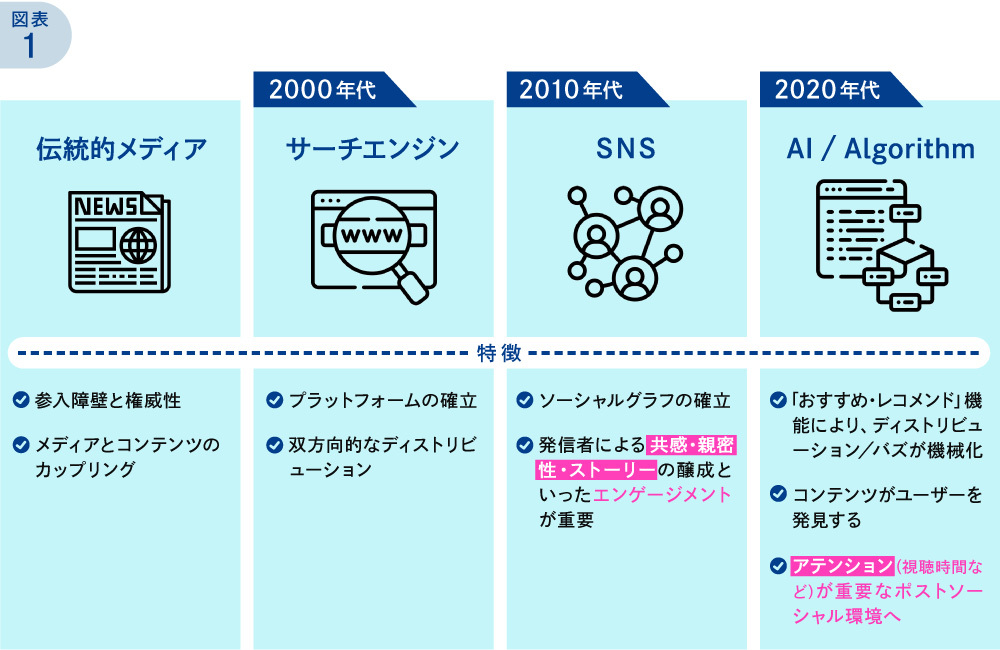
Amano: Algorithms taking over how we encounter information and content changes the information behavior model.Previously, it was the passive "AIDMA" model. The advent of search engines shifted it to the active "AISAS" model. Now, with AI and algorithms, I believe we've evolved to "ALSAS." Algorithms learn from what you've viewed and recommend content, making it both active and passive. In other words, it's a mid-active encounter with information. (Figure 2)
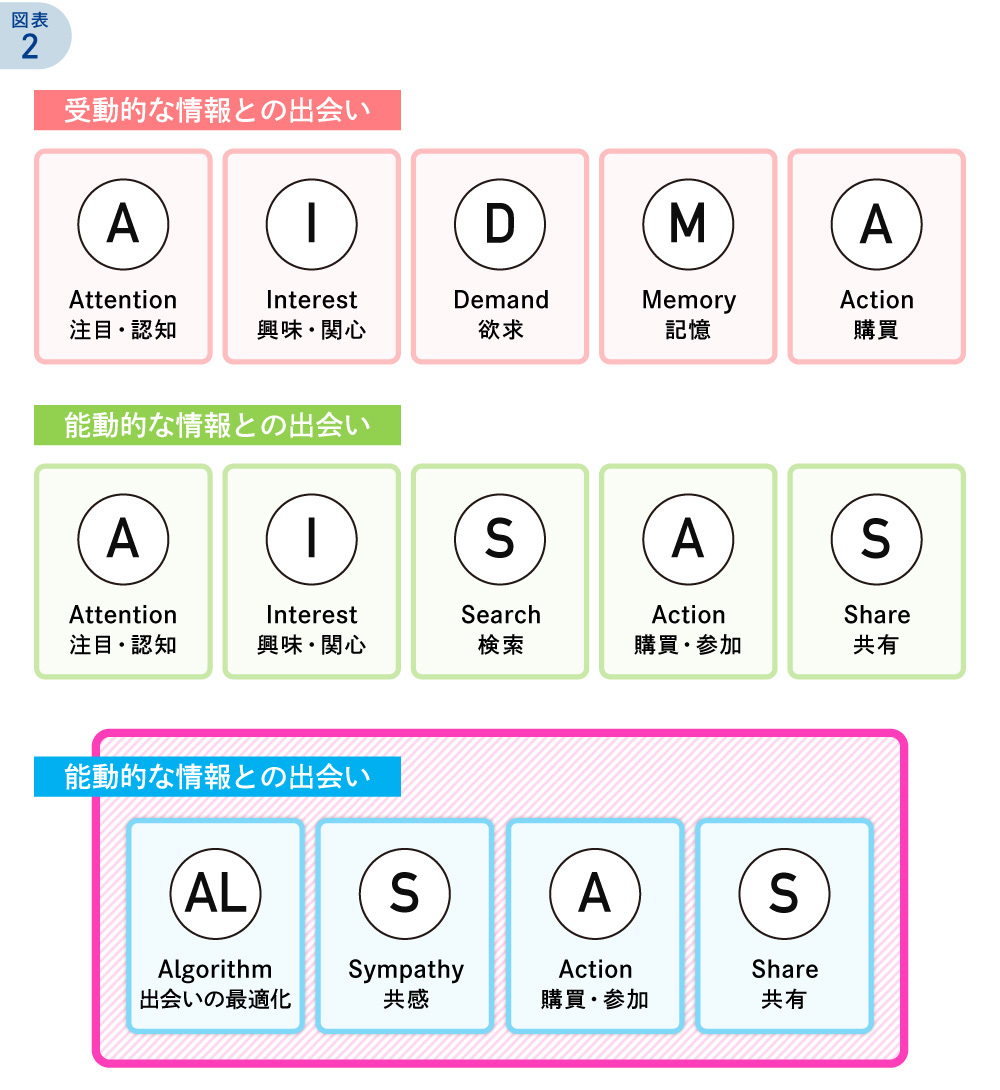
Amano: Short videos play a crucial role in this "encounter." Earlier, we discussed the importance of creating diverse creative content and tailoring it for distribution. Attention-grabbing short videos like TikTok or YouTube snippets act as "lead-off hitters," guiding users toward main content.
Watanabe: I've personally experienced being unintentionally drawn to the full video after watching a short clip on YouTube that highlighted the most interesting parts. It's exactly like a lead-off hitter. Nagata-san, I'd like to ask you: How does Generation Z perceive AI and algorithms?
Nagata: Gen Z recognizes that social media algorithms optimize information for them and naturally uses them for gathering information. They also understand the differences between platforms. They effectively utilize AI too, like creating job application forms with ChatGPT. Rather than feeling controlled, I think they understand the technology and approach it with a mindset similar to that of a flat friend.
Amano: Understanding technology is also crucial for content creators. For traditional media like TV and newspapers, there used to be only one platform for content distribution. But now, platforms like the internet and social media have opened up numerous avenues. Since the strength of TV and newspaper content remains unchanged, it's vital to understand technology and leverage these diverse distribution channels.
Perspective ④ for Understanding Today: "Worldview" as a Communication Tool
Watanabe: You two have published a book summarizing insights about Gen Z and social media derived from your research. A common theme in that book was the importance of "worldview." Could you explain again what function or effect "worldview" serves for consumers, and how companies should understand it?
Nagata: For young people, "worldview" is a communication tool. We call it visual communication. They judge whether they're compatible with or can become friends with someone based on the worldview conveyed through videos and images.Even within the "scenes" I mentioned earlier, worldview is highly valued—it could be considered the core axis of communication. For example, if you ask young people to explain the feeling of "emo," they seem to struggle. But if you ask them to "bring me an emo photo," they all bring similar images. I think the development of SNS has made visuals a common language, naturally shifting the axis of communication toward the visual.
Worldview also influences product selection. In fashion, for instance, a young person who loves French girly style first has that French girly worldview. They then buy a product because it's necessary for that worldview... that's the behavior happening. In other words, having a cherished worldview and consuming by working backwards from that worldview is becoming the norm.
Considering this, companies should also change their product development approach. Products that only have a self-contained worldview within themselves won't be chosen. Rather than companies unilaterally providing, I think a stance is needed where they enter the trends of the worldview that everyone is collectively creating.
Amano: Regarding communication from companies and brands, I think it's also crucial whether consumers perceive them as consistent entities. This refers to the "worldview" stemming from the context and philosophy behind what companies and brands communicate. If what they say or their attitude differs from the past, it gets exposed immediately nowadays. It's vital to first understand how consumers perceive them and what worldview they are thought to embody, then figure out how to align with that.
Watanabe: So we must be mindful of aligning with the worldview as seen by consumers.
Deepening the Relationship Between Companies and Consumers
Watanabe: We've discussed the changing values, consumption behaviors, and media habits of Generation Z and consumers in general. So, how should companies build relationships with these consumers? Given the major challenge of population decline, who should companies focus on and how?
Nagata: It's true, especially the younger generation's population is shrinking. We sometimes get asked if companies really need to market to young people. However, young people are more adept than other generations at spreading things via social media and creating trends. They possess influence that can't be measured by simple numbers alone. Maritozzo, for example, was a trend born from young people and spread throughout society. That kind of power is something other generations don't have.
Leveraging this power is crucial for companies. The key lies in determining which youth communities to engage and how to collaborate with them to amplify enthusiasm and create buzz. This is essential for building meaningful relationships between companies and young people.
Watanabe: So the key perspective isn't just targeting youth in general, but identifying which specific communities to win over.
Amano: In the relationship between companies and consumers, as mentioned earlier, I believe consistency in the company or brand is crucial. For example, more companies are communicating their SDGs initiatives. However, if a company has a history of genuinely environmentally conscious practices, it's accepted. But if not, it comes across as "superficial." It's essential to clearly identify which communities will support you. Thanks to SNS, consumer impressions are becoming easier to gauge.
Another keyword I'm interested in is "age-neutralization." With information easily shared on social media, everyone tends to like the same things. I think consumption behavior that transcends age boundaries will increase going forward, so I want to keep a close eye on this trend.
Watanabe: If companies can match with consumers who support them, they might be able to deepen relationships regardless of age.
Outlook for Future Consumers
Watanabe: Finally, I'd like to hear each of your perspectives on the outlook for consumers going forward.
From the Human Research Institute, from a corporate perspective, it's crucial that as consumers increasingly demand lower "choice costs," companies need to ensure their offerings appear within the information presented by AI and algorithms. Simultaneously, we must identify consumers' "new time" and how they allocate "money and effort."
Amano: I intend to keep watching three key points: "How deeply AI will penetrate across generations and personalities," "How major movements like HYPE※ emerge within the highly segmented world of social media," and "While attention tends to focus on changing values, what remains 'unchanging'?" Moving forward, how people use media and their values will continue to be mutually interlinked. This will give rise to new challenges, which I believe will lead to new business opportunities.
HYPE... Originally meant exaggerated advertising, but recently it refers to situations where something is "trending, wildly popular, and enthusiastically embraced." (Amano)
Nagata: I want to focus on how the generation that grew up with games, NFTs, and virtual worlds as the norm will change their spending habits and time allocation as they mature—what platforms they'll use and how they'll communicate.
Another point: I believe values regarding happiness are shifting. The traditional focus on growth and success is becoming less necessary for younger generations. This is a very fundamental need, one that I think will influence consumption behavior, so I want to research it.
Watanabe: Through this session, I was reminded that for companies to seize new business opportunities, it's crucial to increase the resolution of consumer insights from various perspectives, including values and media behavior. I believe we gained many valuable hints today. Thank you all for your time.









